Effects of Mixed Microcapsules in Different Proportions on Aging Resistance and Self-Healing Properties of Waterborne Coatings for Tilia europaea L
Abstract
:1. Introduction
2. Experimental Section
2.1. Materials
2.2. Methods
- (1)
- Preparation of melamine/RHP-coated shellac microcapsules
- (2)
- Preparation of self-healing waterborne coating
2.3. Testing and Characterization
3. Results and Discussion
3.1. Morphology and Chemical Composition Analysis of Microcapsules with Different Contents of RHP
3.1.1. Morphology Characterization of Microcapsules
3.1.2. Infrared Spectra Testing
3.2. Optical and Mechanical Properties Analysis
3.2.1. Chromatism
3.2.2. Gloss
3.2.3. Mechanical Properties
3.2.4. Microstructure
3.3. Aging Resistance Performance Analysis
3.3.1. Chromatism
3.3.2. LLR
3.3.3. Microstructure
3.3.4. Infrared Spectrum Analysis
3.4. Self-Healing Performance Analysis
3.5. Roughness Test of Waterborne Coating with Mixed Microcapsules
4. Conclusions
Author Contributions
Funding
Institutional Review Board Statement
Informed Consent Statement
Data Availability Statement
Conflicts of Interest
References
- Li, X.L.; Zhang, M.; Yang, L.J.; Yue, X.Y.; Xiong, X.Q. Current state and development trend of China’s customized home furnishing industry. Wood Mater. Sci. Eng. 2024. [Google Scholar] [CrossRef]
- Yue, X.Y.; Xiong, X.Q.; Xu, X.T.; Zhang, M. Big data for furniture intelligent manufacturing: Conceptual framework, technologies, applications, and challenges. Int. J. Adv. Manuf. Technol. 2024, 132, 5231–5247. [Google Scholar] [CrossRef]
- Wang, G.K.; Xiong, X.Q.; Ma, Y.; Xu, X.T. Application of a digital twin model in the packaging process of the panel furniture industry. For. Prod. J. 2024, 74, 98–106. [Google Scholar] [CrossRef]
- Zhou, C.; Huang, T.; Luo, X.; Kaner, J. Reorganisation and construction of an age-friendly smart recreational home system: Based on function capability match methodology. Appl. Sci. 2023, 13, 9783. [Google Scholar] [CrossRef]
- Panzarasa, G.; Burgert, I. Designing functional wood materials for novel engineering applications. Holzforschung 2022, 76, 211–222. [Google Scholar] [CrossRef]
- Liang, H.S.; Wu, Z.H.; Du, S.J. Study on the impact of environmental awareness, health consciousness, and individual basic conditions on the consumption intention of green furniture. Sustain. Futures 2024, 8, 100245. [Google Scholar] [CrossRef]
- Luo, Z.Y.; Xu, W.; Wu, S.S. Performances of green velvet material (PLON) used in upholstered furniture. Bioresources 2023, 18, 5108–5119. [Google Scholar] [CrossRef]
- Weng, M.Y.; Zhu, Y.T.; Mao, W.G.; Zhou, J.C.; Xu, W. Nano-silica/urea-formaldehyde resin-modified fast-growing lumber performance study. Forests 2023, 14, 1440. [Google Scholar] [CrossRef]
- Luo, Y.R.; Xu, W. Optimization of panel furniture plates rework based on intelligent manufacturing. Bioresources 2023, 18, 5198–5208. [Google Scholar] [CrossRef]
- Qi, Y.Q.; Zhang, Z.Q.; Sun, Y.; Shen, L.M.; Han, J.L. Study on the process optimization of peanut coat pigment staining of poplar wood. Forests 2024, 15, 504. [Google Scholar] [CrossRef]
- Hu, W.; Liu, N.; Xu, L.; Guan, H. Study on cold/warm sensation of materials used in desktop of furniture. Wood Res. 2020, 65, 497–506. [Google Scholar] [CrossRef]
- Chen, Y.T.; Sun, C.S.; Ren, Z.R.; Na, B. Review of the current state of application of wood defect recognition technology. BioResources 2023, 18, 2288–2302. [Google Scholar] [CrossRef]
- Wang, C.; Zhang, C.Y.; Ding, K.Q.; Jiang, M.H. Immersion polishing post-treatment of PLA 3D printed formed parts on its surface and mechanical performance. BioResources 2023, 18, 7995–8006. [Google Scholar] [CrossRef]
- Hu, W.; Wan, H. Comparative study on weathering durability properties of phenol formaldehyde resin modified sweetgum and southern pine specimens. Maderas-Cienc. Tecnol. 2022, 24, 17. [Google Scholar] [CrossRef]
- Durmaz, S.; Ozgenc, O.; Avci, E.; Boyaci, I.H. Weathering performance of waterborne acrylic coating systems on flat-pressed wood-plastic composites. J. Appl. Polym. Sci. 2020, 137, 48518. [Google Scholar] [CrossRef]
- Liu, Y.; Wu, Z. Fabrication of coatings with structural color on a wood surface. Coatings 2020, 10, 32. [Google Scholar] [CrossRef]
- Sang, R.J.; Yang, F. Effect of TiO2@CaCO3 waterborne primer on the coloring performance of inkjet-printed wood product coatings. Coatings 2023, 13, 2071. [Google Scholar] [CrossRef]
- Chang, Y.J.; Wu, Z.H. Synthesized high performance UV-cured wood wax oil using Irgacure 2959 modified thistle oil and linseed oil. Ind. Crop. Prod. 2024, 218, 118952. [Google Scholar] [CrossRef]
- Zhu, J.; Wu, Z.; Xiong, D.; Pan, L.; Liu, Y. Preparation and properties of a novel low crystallinity cross-linked network waterborne polyurethane for water-based ink. Prog. Org. Coat. 2019, 133, 161–168. [Google Scholar] [CrossRef]
- Agnol, L.D.; Dias, Z.; Yan, F.T.G.; Ornaghi, H.L.; Sangermano, M.; Bianchi, O. UV-curable waterborne polyurethane coatings: A state-of-the-art and recent advances review. Prog. Org. Coat. 2021, 154, 106156. [Google Scholar] [CrossRef]
- Liu, Q.Q.; Gao, D.; Xu, W. Effect of paint process on the performance of modified poplar wood antique. Coatings 2021, 11, 1174. [Google Scholar] [CrossRef]
- Ling, K.L.; Feng, Q.M.; Huang, Y.H.; Li, F.; Huang, Q.F.; Zhang, W.; Wang, X.C. Effect of modified acrylic water-based paint on the properties of paint film. Spectrosc. Spect. Anal. 2020, 40, 2133–2137. [Google Scholar]
- Zhang, H.Q.; Feng, X.H.; Wu, Y.; Wu, Z.H. Factors influencing the properties of UV-cured self-matting film. Prog. Org. Coat. 2024, 189, 108241. [Google Scholar] [CrossRef]
- Li, H.Y.; Cui, Y.X.; Li, Z.K.; Zhu, Y.J.; Wang, H.Y. Fabrication of microcapsules containing dual-functional tung oil and properties suitable for self-healing and self-lubricating coatings. Prog. Org. Coat. 2018, 115, 164–171. [Google Scholar] [CrossRef]
- Song, Y.; Chen, K.F.; Wang, J.J.; Liu, Y.; Qi, T.; Li, G.L. Synthesis of polyurethane/poly(urea-formaldehyde) double-shelled microcapsules for self-healing anticorrosion coatings. Chin. J. Polym. Sci. 2020, 38, 45–52. [Google Scholar] [CrossRef]
- Tezel, O.; Cigil, A.B.; Kahraman, M.V. Dual microcapsules based epoxy/polyethyleneimine autonomous self-healing system for photo-curable coating. Polym. Advan. Technol. 2021, 32, 553–563. [Google Scholar] [CrossRef]
- Uzoma, P.C.; Liu, F.C.; Han, E.H. Multi-stimuli-triggered and self-repairable fluorocarbon organic coatings with urea-formaldehyde microcapsules filled with fluorosilane. J. Mater. Sci. Technol. 2020, 45, 70–83. [Google Scholar] [CrossRef]
- Bar, H.; Bianco-Peled, H. The unique nanostructure of shellac films. Prog. Org. Coat. 2021, 157, 106328. [Google Scholar] [CrossRef]
- Patel, A.R.; Remijn, C.; Cabero, A.I.M.; Heussen, P.C.M.; Hoorn, J.W.M.S.; Velikov, K.P. Novel all-natural microcapsules from gelatin and shellac for biorelated applications. Adv. Funct. Mater. 2013, 23, 4710–4718. [Google Scholar] [CrossRef]
- Weththimuni, M.L.; Milanese, C.; Licchelli, M.; Malagodi, M. Improving the protective properties of shellac-based varnishes by functionalized nanoparticles. Coatings 2021, 11, 419. [Google Scholar] [CrossRef]
- Naikwadi, A.T.; Samui, A.B.; Mahanwar, P.A. Melamine-formaldehyde microencapsulated n-Tetracosane phase change material for solar thermal energy storage in coating. Sol. Energ. Mat. Sol. C 2020, 215, 110676. [Google Scholar] [CrossRef]
- Satdive, A.; Mestry, S.; Patil, D.; Mhaske, S.T. Synthesis of melamine formaldehyde cured castor oil based hydroxyl functional alkyd for coating application. Prog. Org. Coat. 2019, 131, 165–175. [Google Scholar] [CrossRef]
- Liu, E.W.; Wu, Z.H. Preparation and characterization of cellulose nanofibers/polybenzoxazine–poly(vinyl alcohol) double network foam based on multiple hydrogen bond structure. ACS Appl. Polym. Mater. 2024, 6, 6219–6228. [Google Scholar] [CrossRef]
- Yap, S.Y.; Sreekantan, S.; Hassan, M.; Sudesh, K.; Ong, M.T. Characterization and biodegradability of rice husk-filled polymer composites. Polymers 2021, 13, 104. [Google Scholar] [CrossRef] [PubMed]
- Yan, X.X.; Han, Y.; Yin, T.Y. Coating process optimization and self-healing performance evaluation of shellac microcapsules coated with melamine/rice husk powder. Appl. Sci. 2021, 11, 8373. [Google Scholar] [CrossRef]
- Yan, X.X.; Han, Y.; Yin, T.Y. Synthesis of urea-formaldehyde microcapsule containing fluororesin and its effect on performances of waterborne coatings on wood surface. Polymers 2021, 13, 1674. [Google Scholar] [CrossRef] [PubMed]
- Yan, X.X.; Wang, L. Preparation of shellac resin microcapsules coated with urea formaldehyde resin and properties of waterborne paint films for Tilia amurensis Rupr. Membranes 2020, 10, 278. [Google Scholar] [CrossRef] [PubMed]
- Li, W.B.; Yan, X.X. Effects of shellac self-repairing and carbonyl iron powder microcapsules on the properties of Dulux waterborne coatings on wood. Polymers 2023, 15, 2016. [Google Scholar] [CrossRef] [PubMed]
- GB/T 4893.6-2013; Test of Surface Coatings of Furniture-Part 6: Determination of Gloss Value. Standardization Administration of the People’s Republic of China: Beijing, China, 2013.
- GB/T 6739-2022; Paints and Varnishes-Determination of Film Hardness by Pencil Test. Standardization Administration of the People’s Republic of China: Beijing, China, 2022.
- GB/T 4893.4-2013; Test of Surface Coatings of Furniture-Part 4: Determination of Adhesion—Cross Cut. Standardization Administration of the People’s Republic of China: Beijing, China, 2013.
- GB/T 1732-2020; Determination of Impact Resistance of Coating Films. Standardization Administration of the People’s Republic of China: Beijing, China, 2020.
- BS EN 15977-2011; Rubber or plastic coated fabrics. Mechanical properties. Determination of the elongation under load and the residual deformation. British Standards Institution: London, UK, 2011.
- Hu, W.G.; Yu, R.Z. Study on the strength mechanism of the wooden round-end mortise-and-tenon joint using the digital image correlation method. Holzforschung 2024. [Google Scholar] [CrossRef]
- Hu, W.G.; Luo, M.Y.; Yu, R.Z.; Zhao, Y. Effects of the selected factors on cyclic load performance of T-shaped mortise-and-tenon furniture joints. Wood Mater. Sci. Eng. 2024. [Google Scholar] [CrossRef]
- Zhao, B.B.; Jiao, C.L.; He, W.; Ma, Y.X.; Sun, S.X.; Du, W.H.; Cheng, Y. Optimization of the branched structure to enhance the corrosion protection of waterborne acrylic-alkyd resins on iron-based materials. Prog. Org. Coat. 2024, 194, 108568. [Google Scholar] [CrossRef]
- Zhu, Y.; Li, W.B.; Yan, X.X. Effect of Blending of Shellac, Carbonyl Iron Powder, and Carbonyl Iron Powder/Carbon Nanotube Microcapsules on the Properties of Coatings. Coatings 2024, 14, 75. [Google Scholar] [CrossRef]
- Zou, Y.M.; Xia, Y.X.; Yan, X.X. Effect of UV Top Coating Microcapsules on the Coating Properties of Fiberboard Surfaces. Polymers 2024, 16, 2098. [Google Scholar] [CrossRef] [PubMed]


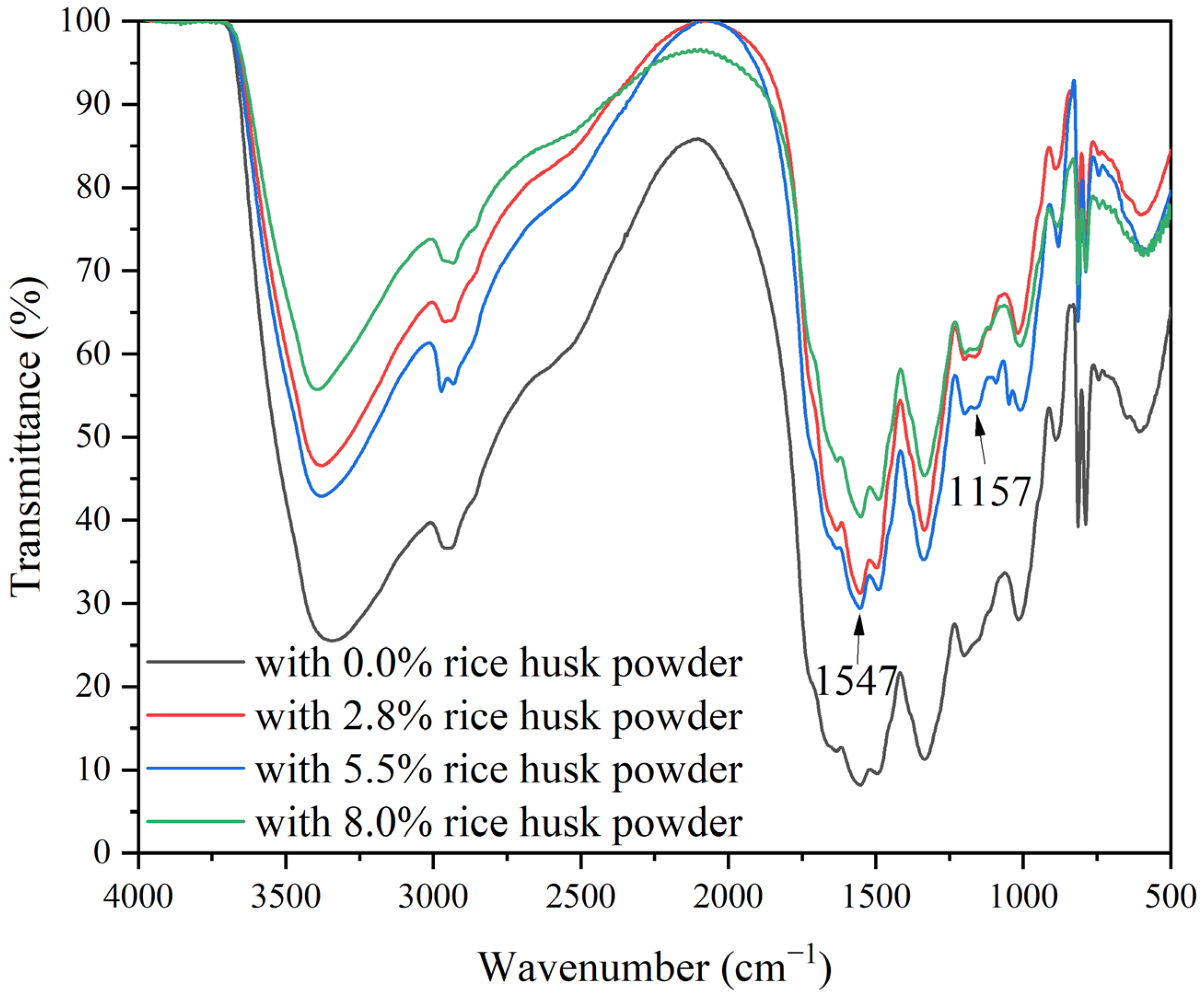
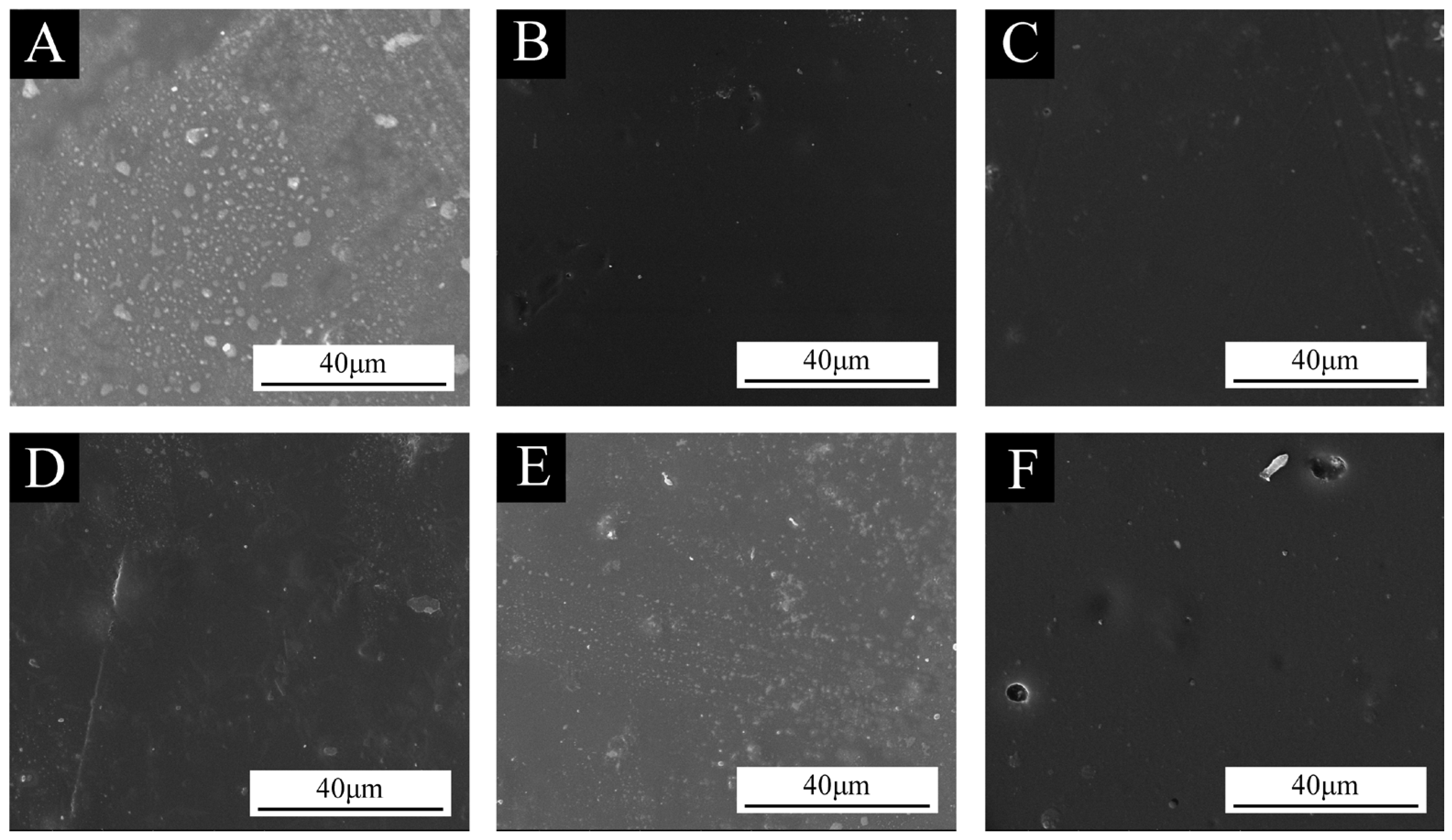

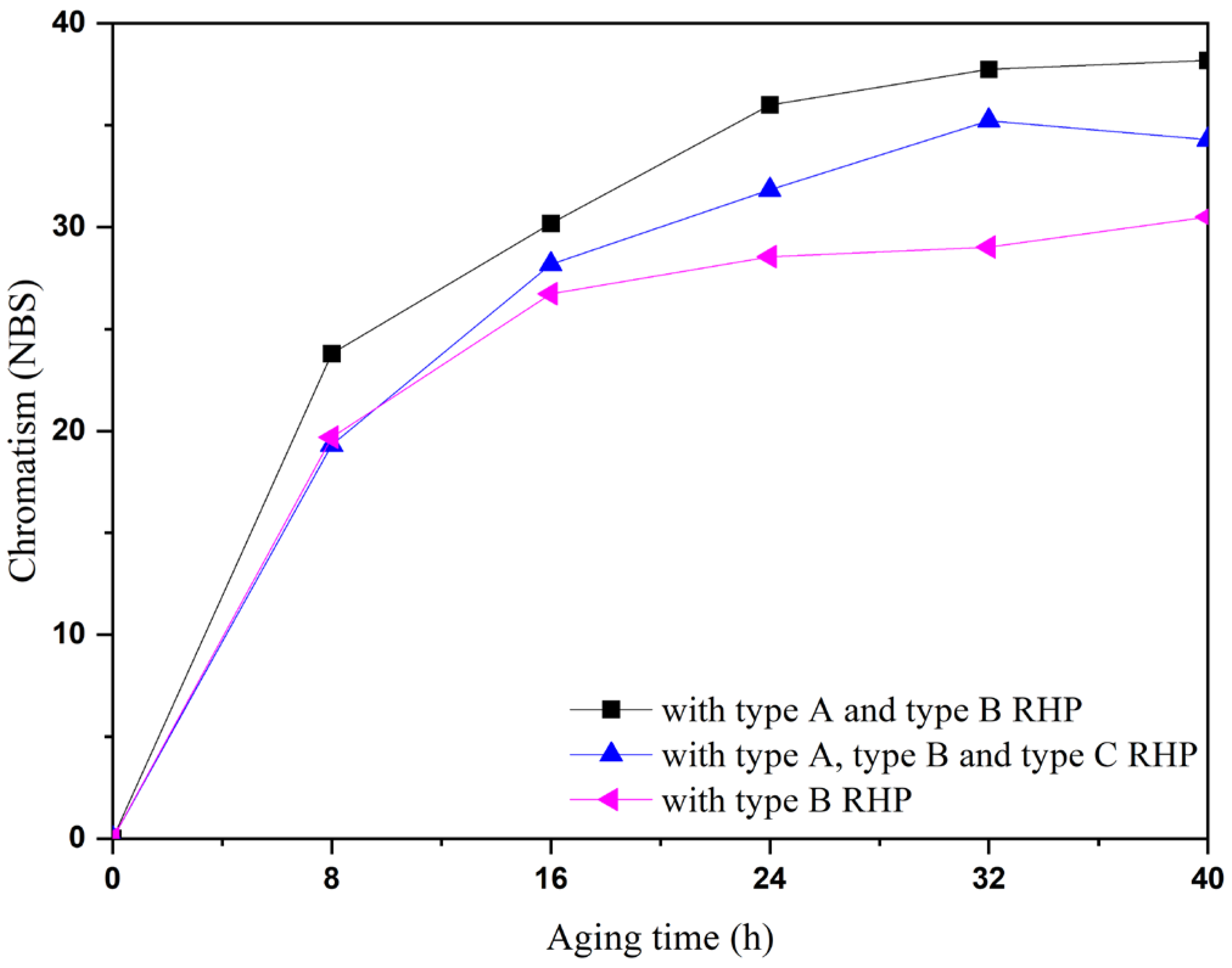
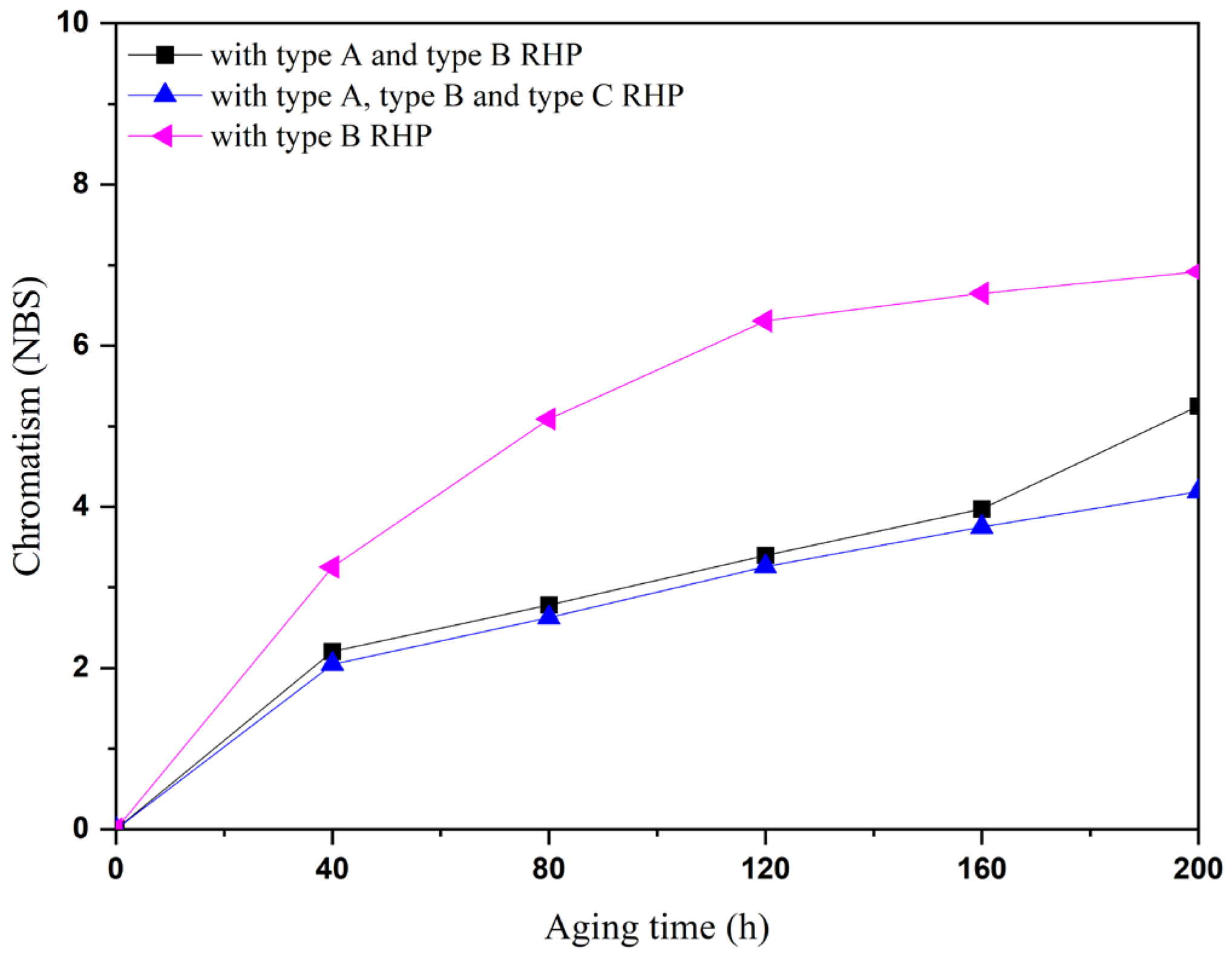
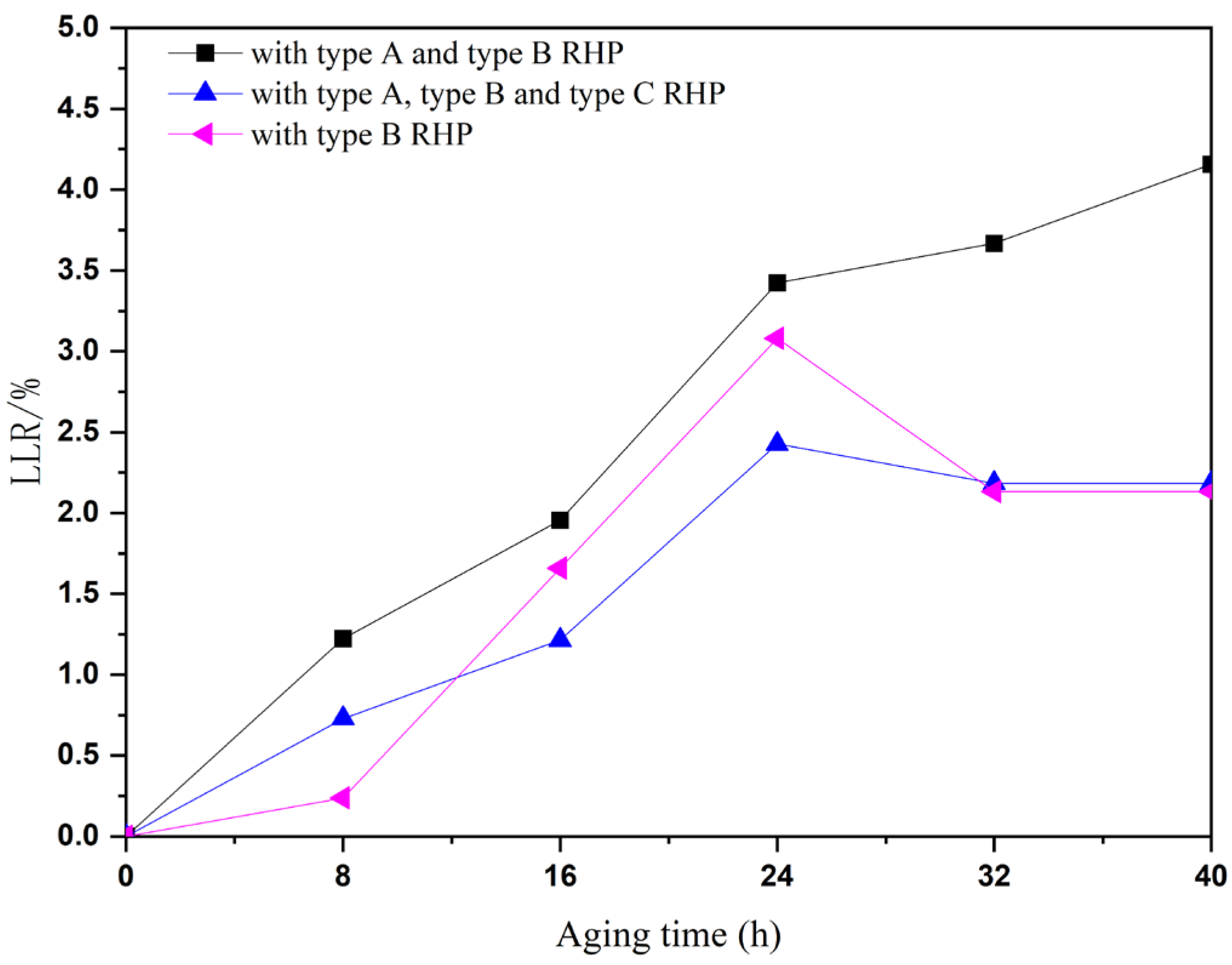

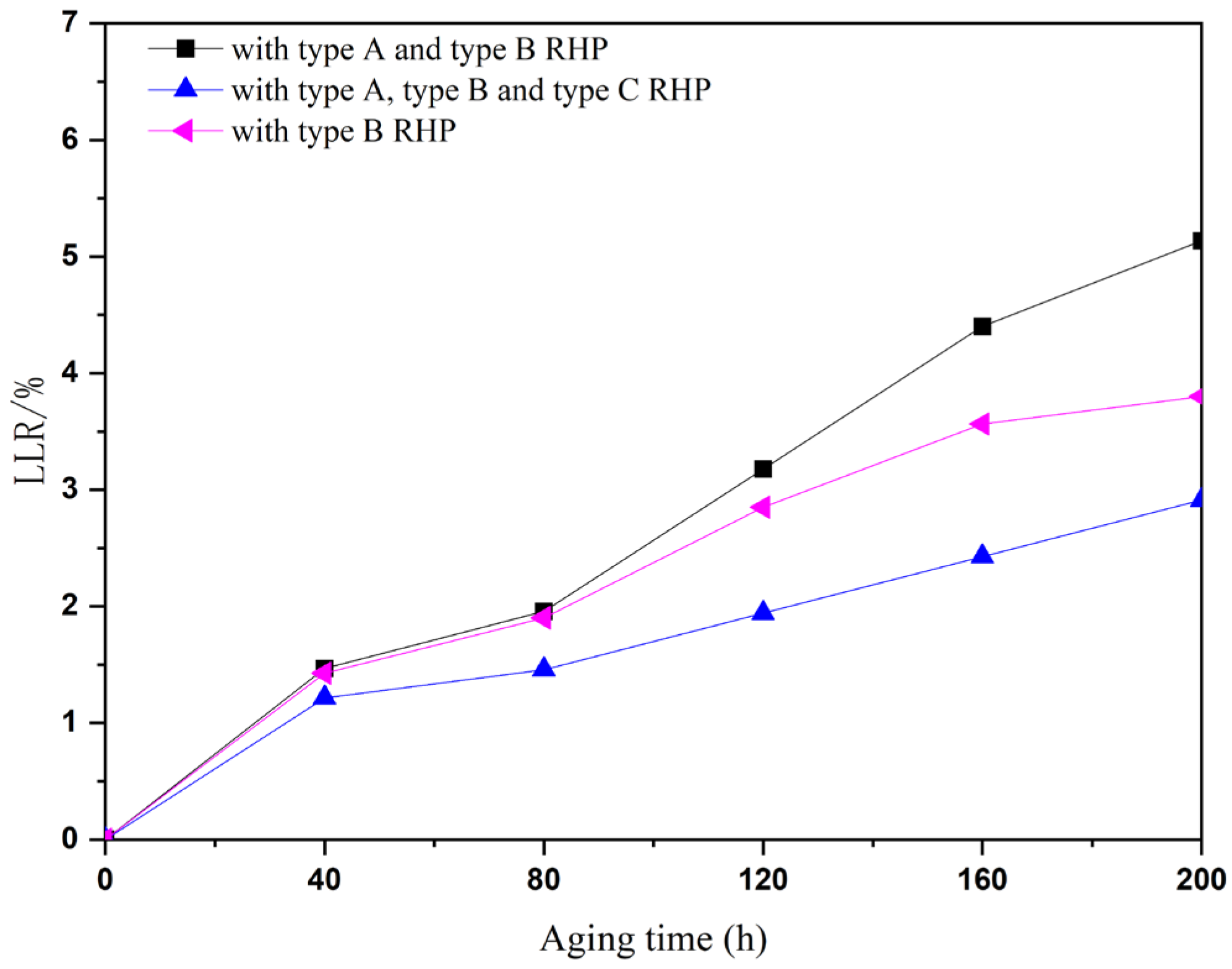



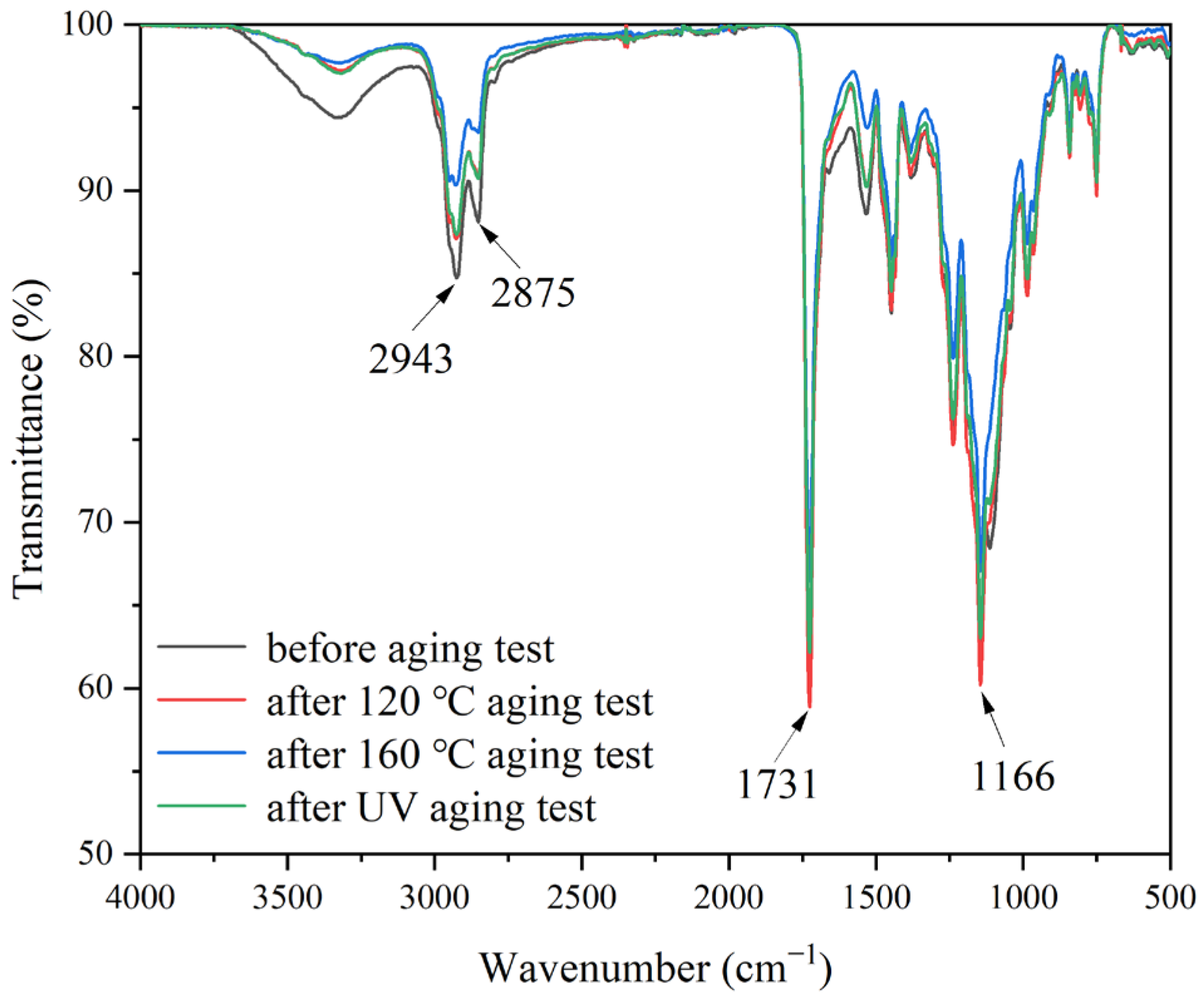


| Type | RHP Content (%) | RHP (g) | Melamine (g) | 37% Formaldehyde Solution (g) | Shellac (g) |
|---|---|---|---|---|---|
| A | 2.8 | 0.25 | 5.00 | 10.00 | 6.64 |
| B | 5.5 | 0.50 | 5.00 | 10.00 | 6.83 |
| C | 8.0 | 0.75 | 5.00 | 10.00 | 7.01 |
| Coating Number (#) | Kind of Mixed Microcapsules | Mixing Ratio (%) | Mass of Microcapsules (g) | Mass of Primer (g) | Mass of Finish (g) | Mass of Waterborne Coatings (g) |
|---|---|---|---|---|---|---|
| 1 | type A + type B | 1:1 | 0.12 | 1.88 | 2.00 | 4.00 |
| 2 | type B + type C | 1:1 | 0.12 | 1.88 | 2.00 | 4.00 |
| 3 | type A + type B + type C | 1:1:1 | 0.12 | 1.88 | 2.00 | 4.00 |
| 4 | type A | 1 | 0.12 | 1.88 | 2.00 | 4.00 |
| 5 | type B | 1 | 0.12 | 1.88 | 2.00 | 4.00 |
| 6 | type C | 1 | 0.12 | 1.88 | 2.00 | 4.00 |
| Sample Number (#) | L1 | a1 | b1 | L2 | a2 | b2 | ΔL | Δa | Δb | ΔE |
|---|---|---|---|---|---|---|---|---|---|---|
| 1 | 72.0 | 12.4 | 23.3 | 71.5 | 13.9 | 23.9 | −0.5 | 1.5 | 0.6 | 1.69 |
| 2 | 70.3 | 13.3 | 31.0 | 70.6 | 12.5 | 29.8 | 0.3 | −0.8 | −1.2 | 1.47 |
| 3 | 70.8 | 13.8 | 27.7 | 70.6 | 14.2 | 28.7 | −0.2 | 0.4 | 1.0 | 1.10 |
| 4 | 73.8 | 13.4 | 30.6 | 72.2 | 13.6 | 31.1 | −1.6 | 0.2 | 0.5 | 1.69 |
| 5 | 67.2 | 15.0 | 28.2 | 67.8 | 15.3 | 28.8 | 0.6 | 0.3 | 0.6 | 0.90 |
| 6 | 68.5 | 15.8 | 32.0 | 69.1 | 15.2 | 30.8 | 0.6 | −0.6 | −1.2 | 1.47 |
| Sample Number (#) | Gloss at the Incident Angle of 20° (%) | Gloss at the Incident Angle of 60° (%) | Gloss at the Incident Angle of 85° (%) |
|---|---|---|---|
| 1 | 12.3 | 32.7 | 37.5 |
| 2 | 11.1 | 29.8 | 35.1 |
| 3 | 16.8 | 40.0 | 48.8 |
| 4 | 14.5 | 40.6 | 46.1 |
| 5 | 19.3 | 43.0 | 55.4 |
| 6 | 8.3 | 27.8 | 29.4 |
| Sample Number (#) | Adhesion | Hardness | Impact Resistance (kg·cm) | Elongation at Break (%) |
|---|---|---|---|---|
| 1 | 0 | 4 H | 5 | 33.71 |
| 2 | 0 | 4 H | 10 | 26.05 |
| 3 | 0 | 4 H | 7 | 35.28 |
| 4 | 0 | 4 H | 5 | 28.62 |
| 5 | 0 | 4 H | 10 | 30.90 |
| 6 | 0 | 4 H | 10 | 23.59 |
Disclaimer/Publisher’s Note: The statements, opinions and data contained in all publications are solely those of the individual author(s) and contributor(s) and not of MDPI and/or the editor(s). MDPI and/or the editor(s) disclaim responsibility for any injury to people or property resulting from any ideas, methods, instructions or products referred to in the content. |
© 2024 by the authors. Licensee MDPI, Basel, Switzerland. This article is an open access article distributed under the terms and conditions of the Creative Commons Attribution (CC BY) license (https://creativecommons.org/licenses/by/4.0/).
Share and Cite
Xia, L.; Han, Y.; Yin, T.; Zhu, Y.; Yan, X.; Li, J. Effects of Mixed Microcapsules in Different Proportions on Aging Resistance and Self-Healing Properties of Waterborne Coatings for Tilia europaea L. Coatings 2024, 14, 1042. https://doi.org/10.3390/coatings14081042
Xia L, Han Y, Yin T, Zhu Y, Yan X, Li J. Effects of Mixed Microcapsules in Different Proportions on Aging Resistance and Self-Healing Properties of Waterborne Coatings for Tilia europaea L. Coatings. 2024; 14(8):1042. https://doi.org/10.3390/coatings14081042
Chicago/Turabian StyleXia, Lingran, Yan Han, Taiyu Yin, Ye Zhu, Xiaoxing Yan, and Jun Li. 2024. "Effects of Mixed Microcapsules in Different Proportions on Aging Resistance and Self-Healing Properties of Waterborne Coatings for Tilia europaea L" Coatings 14, no. 8: 1042. https://doi.org/10.3390/coatings14081042




